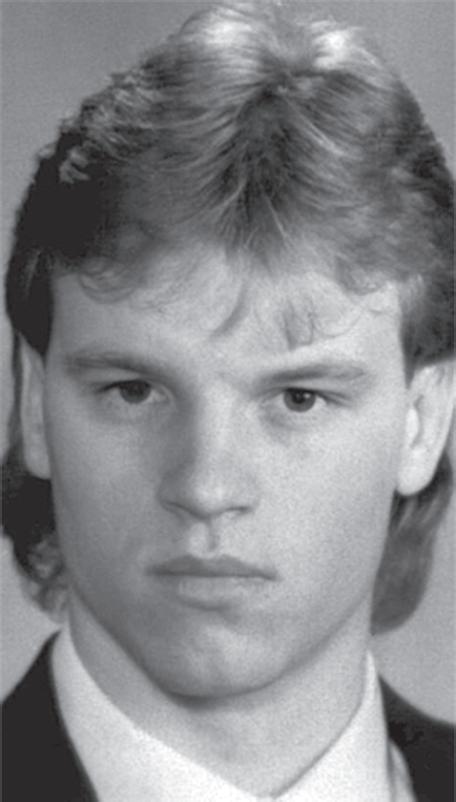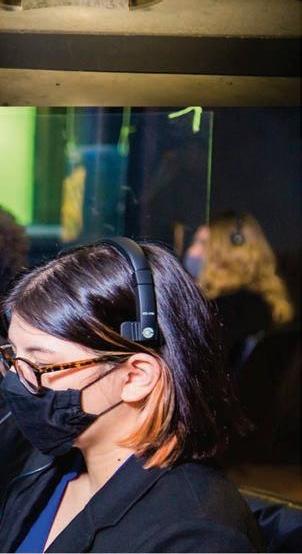
15 minute read
SATANIC RITUALS
Kidnap, murder, ritual sacrifice
Student’s death in Matamoros led to 1989 Texas legislation
Advertisement
In 1989, Texas was gripped by a “Satanic Panic,” following a discovery of a mass grave in Matamoros, Mexico. The grave filled with 15 dismembered bodies was discovered as a result of a routine missing-persons investigation of Mark Kilroy, a Texas student who disappeared on spring break. What followed is a tale of ritual sacrifice that led to legislation that stayed in effect for four years.
A SPRING BREAK TRIP
In the early hours of Saturday, March 11, 1989, Kilroy, a senior at University of Texas at Austin, Bill Huddleston and Bradley Moore, both juniors at Texas A&M, and Brent Martin, a student at Alvin Community College, in Alvin, Texas, piled into Martin’s car and headed to South Padre Island. The friends were former high school basketball and baseball teammates in Santa Fe, Texas. They had planned a week of drinking, sunbathing and partying on the beach.
The next day, the quartet made a trip through Brownsville and crossed the Rio Grande into Mexico to visit Matamoros’s main tourist attraction, Calle Alvaro Obregon, that houses a large selection of bars that sold cheap alcohol. The guys met up with four Kansas coeds and partied until about 2:30 a.m. and went back to their hotel.
The following day, they decided to revisit Matamoros again, but this time, they left their car on the American side of the border and walked to the risqué town. While at the Hard Rock Café, Kilroy left his friends to talk to a woman he knew. When the other three were ready to call it a night, Kilroy rejoined the party and they walked back across the bridge to their car. On the way, they stopped to use the restroom, Huddleston said, in an interview with Rolling Stone magazine, they saw a Mexican man motion for them to join him. He assumed Kilroy knew him because he heard Kilroy ask the man, “Didn’t I just see you somewhere?” or “Where did I last see you?” When Huddleston rejoined Martin and Moore, Kilroy was not with them. They assumed he had gotten a ride with someone else, and they returned to their hotel. By the next day, however, Kilroy had not returned.
The friends contacted the police and filed a missing-persons report. The police said that students were commonly reported missing and usually showed up hours later with a hangover and no memory of the night before. However, the disappearance of Kilroy was soon suspected as foul-play, once he could not be located in the hospitals or jails. Investigators decided to bring in a hypnotist to uncover clues. Under hypnosis, Martin recalled Kilroy talking to a young Hispanic man with a cut on his face. There were no other leads.
Kilroy’s parents, James and Helen Kilroy, flew to Brownsville and led the search for their son. They passed out more than 20,000 leaflets and offered a $15,000 reward for information concerning his whereabouts. The Kilroys met with Texas officials, including Attorney General Gene Mattox, Governor William Clements and Senator Lloyd Bentsen. On Sunday, March 26, the Kilroy case was featured on “America’s Most Wanted.” The television show produced an outpouring of mail and telephone calls but no clues. The Kilroys left a few days later with the police’s promise to not give up the search for their son.
A BREAK IN THE CASE
A few days before the Kilroys returned home, the United States and Mexico announced the implementation of a massive drug interdiction program along the border. The antidrug operation included 1,200 agents, helicopters and airplanes. It was described by one official as “possibly the largest of its kind.” In April, a few weeks after Kilroy’s disappearance, Elio Hernandez Rivera, 22, a resident of Matamoros, was arrested for running a routine police roadblock and for being in possession of marijuana. Under police questioning, Rivera identified several drug dealers and revealed his family had a small ranch 20 miles west of Matamoros. The police handcuffed Rivera and took him to the Santa Elena Ranch, that had a reputation among the officers for staging a ring of marijuana smugglers. The police group was led by Comandante Juan Benitez Ayala of the Mexican Federal Police; they uncovered 75 pounds of marijuana on the property.
In a routine procedure, the police officers passed a photo of Kilroy to the ranch caretaker. He told them that he had seen the young man and pointed to a shack 400-feet away from where they were standing. A GRUESOME DISCOVERY
As the police officers approached the building, they were engulfed in a stench of rotting flesh. Buried in several shallow graves, were 12 male bodies, including the body of Mark Kilroy. The victims had been slashed with knives, while others were shot as well. One body was burned, and another was hanged. Many were savagely disfigured with their hearts ripped out, their eyes, ears and testicles removed. One had been decapitated. Three more bodies would be found during the investigation, bringing the total body count to 15.
Inside the building, police found blood covering the floors, as well as an iron kettle filled with iron and wood spikes, a charred human brain and a roasted turtle. They found urns that contained congealed blood, human hair and animal parts. Police also found a large oil drum that they believed was used to boil the victims. One witness described the scene as a “human slaughterhouse.”
Matamoros, Mexico, is located just across the Rio Grande from Brownsville, Texas. The city is a popular spot for college students who head to south Texas for spring break. Mark Kilroy

Satanic — page 18
According to Rivera’s testimony, along with four others, the victims had been ritually slain in the belief that human sacrifice would make the gang invincible and protect their drug business from the police. Rivera and the other suspects showed no sign of remorse when they recounted the events related to Kilroy. Based on their testimonies, warrants were issued to five other cult members, including Adolfo De Jesus Constanzo, 26, the mastermind and religious leader, and Sara Aldrete, a 24-year-old student at Texas Southmost College in Brownsville — she became known as “the witch.”
Kilroy was kidnapped after Constanzo ordered the sacrifice of an Anglo student. Kilroy had almost escaped, Rivera said, but had been wrestled back into the car and taken to the ranch. After being bound and gagged by tape, he was imprisoned in the shack. Kilroy was told nothing was going to happen to him and the suspects said they fed him eggs, bread and water. Twelve hours after he was captured, Kilroy was led outside, where Constanzo executed him by chopping him in the back of the neck with a machete. When the police found Kilroy’s body in one of the graves at the ranch, his legs had been severed at the knees and his brain and spine had been removed.
Kilroy’s murder highlighted an issue that was already being discussed in the Texas legislature.
CORPUS DELICTI
On May 3, 1989, the Houston Chronicle, in a story headlined “Children ‘bred’ for sacrifices, senators hear,” warned that ritualistic crimes were on the increase in Texas, and that a state senate committee approved legislation to increase penalties for certain offenses — but not murder — against children.
Police officers told the panel they believed members of some cults bred children for human sacrifice and other ceremonial abuses. No one has ever been prosecuted in Texas for human sacrifice, but Walker Veal, director of the Killeen Police Academy, said he had seen a “satanic calendar,” on which some days were marked for human sacrifice, with the sex and age of the desired victim specified.
Steve Baggs, a Department of Public Safety narcotics officer based in Austin, told reporters he knew of 20 to 25 cult-related crimes in Texas during the previous two years involving children and adults and “everything from murder to kidnapping.”
The legislation was filed by Senator Judith Zaffirini, D-Laredo, before the 15 bodies were discovered buried on the Matamoros ranch. Zaffirini called the bill a “first step” in fighting a problem that law enforcement officers were only beginning to recognize.
The bill would enhance the punishment for several crimes, including assault and sexual assault, committed against someone younger than 17 “as part of a ritual or ceremony.” For those crimes, the bill would provide stiffer penalties if ritual elements were involved. A third-degree felony offense, for example, would become second-degree under the bill’s provisions.
Zaffirini introduced the bill at the request of Lee Reed, an Abilene police detective, who said ritualistic abuse was “very systematic and organized” and “much worse” than other child molestation cases. Reed said he had not arrested any suspected offenders, but was trying to build one ritualistic abuse case involving four children.
Information provided by officer Reed, and corroborated by DPS, the Fort Worth Police Department’s Gang Intelligence Unit and others, indicated a growing problem in Texas with ritual abuse and murder. The background bill stated the ritual relationship often goes unmarked for two reasons. One is that law enforcement officers fear the “Geraldo Syndrome,” which is when the media shove a video camera and microphone into one’s face and demand answers. According to Tulsaworld.com, this was originated by Geraldo Rivera, an American television host, who made his reputation by taking his camera to the action and “becoming the news” rather than “covering the news.” This resulted in officers not mentioning a ritual relationship in crimes even when recognized. Secondly, officers were only beginning to get training in recognizing such ritual relationships.
Veal, who said 256 police officers throughout the state attended a seminar on ritualistic crimes in Killeen in 1988, urged senators to, “Give us a law to work with. If we don’t have a Corpus Delicti, we don’t have a crime.” Merriam-Webster defines corpus delicti as “The substantial and fundamental fact necessary to prove the commission of a crime,” and “The material substance, such as the body of the victim of a murder, upon which a crime has been committed.”
According to the bill background, law enforcement officers say ritual abuse can include sexual abuse, sensory deprivation, and actual or illusionary torture of humans or animals. They say the greatest obstacle to investigating such allegations, and the biggest reason they often miss ritual relationships, is that the abused children are terrorized into silence. Groups that supported the bill included the Texas Medical Association and the Texas Council on Family Violence.
A BILL PASSES
On Aug. 14, 1989, Senate Bill 30 was proposed in the Texas Senate and provided three sections of the penal code which provided a higher range of punishment for similar conduct because the victim is a child (Sections 22.04 (b) and (c) (injury to a child or elderly individual), and Section 22.021 (aggravated sexual assault). This higher range of punishment, however, comes into play only when the victim is 14 years or younger. Additionally, there are no provisions of the penal code which increase the range of punishment because of the role of


Texas Attorney General Gene Mattox inspects a ritual sacrifice site in Matamoros, Mexico, in 1989.

Judith Zaffirini UPbeat
the actor’s beliefs in committing the offense or since the offense was committed during a ceremony manifesting the actor’s beliefs. The bill became effective Sept. 1, 1989.
PANIC IN SABINE COUNTY
“In 1989, news stories arose about a satanic cult in a small East Texas town that led to a mass panic,” Stuart Wright, Lamar University Professor in the department of sociology, social work and criminal justice, said. “I decided to go investigate this case. I arranged to interview the county sheriff and some teachers in the high school where the alleged incident took place. I took two senior sociology majors with me so they could get some field experience. I was able to watch local TV video that showed parents panicked and showing up at the high school to pick up their kids after a rumor circulated that a satanic cult was planning to kidnap and murder blonde, blue-eyed girls. The video showed coverage of screaming parents and a chaotic scramble to ‘rescue’ offspring.”
Wright said one woman claimed to have heard that animals were being sacrificed and stuffed into school lockers.
“Others claimed there was blood smeared on the walls of the school gymnasium,” he said. “But TV cameras entered the school building to find none of these things. It turned out to be a vivid case of what we call ‘moral panic’ in sociology.
“I was familiar with the few satanism groups in the U.S. at the time that the first claims arose about satanic ritual abuse. I immediately thought that the claims were far-fetched and not based on any real research. As I looked further into this phenomenon, I found that the claims were driven by rumors and fears, not real evidence.”
STRIKING THE BILL
Four years later, no charges had been filed under SB 30. The 72nd Texas legislature enacted HB 93, which repealed the penal code, except for the sections on capital felonies, murder and capital murder, on Sept. 1, 1994. Committee Substitute Senate Bills 1067 and 532 formed a package to restructure the criminal justice and corrections system in Texas. Each bill is contingent on enactment of the other. CSSB 1067 established a new felony category, reclassifying offenses based on their nature and severity, reconfiguring the probation system and revamping eligibility for parole.
The bill also consolidated provisions within the code, eliminating duplicative sections — such as SB 30. Offenses relevant to the satanic rituals covered in SB 30 fell under the charges that include first-degree murder, aggravated sexual assault, injury to a child (intentional with serious bodily injury), first degree aggravated kidnapping, among others. Offenses that are second-degree are injury to a child (reckless with serious bodily injury), indecency with a child (touching), sexual performance of a child, among others. As such, SB 30, which was introduced with great fanfare, simply disappeared with barely a whimper.
THE END OF THE STORY
Graphic media reports of the Santa Elena killings drew attention to satanism and the occult. Throughout the Rio Grande valley, town meetings and university seminars on voodoo and witchcraft drew overflow crowds, and attendance at churches increased. A false rumor that satanists were planning to kidnap children in retaliation for the Matamoros bust caused hundreds of nervous Texans to pull their children out of school.
Meanwhile, the search for Constanzo and Aldrete took on the dimensions of a holy war. Two weeks after the discovery of the mass grave, the Mexican police burned the shack to the ground and placed a cross over the area. Two weeks after that, the police located Constanzo in an apartment. In a final act of defiance, he began throwing money out of a window and firing his gun at passersby. Constanzo’s ability to bend weaker minds to his will was a talent that served him right up to his death, according to the Rolling Stone article. As police closed in, Constanzo ordered his partner Alvaro De Leon Valdez, to shoot him and his longtime companion Martin Quintana Rodriquez. Aldrete said that Constanzo was telling Valdez, “If he did not shoot him, he would pay for the consequences in hell.”
When police burst into the apartment, they found black candles, two swords, a skull made of white wax and a blindfolded doll holding another doll. Constanzo and Quintana were found slumped together in a small closet, their bodies filled with bullet holes. Constanzo, was his own last victim.
De Leon Valdez, Aldrete and three other occult members were charged with homicide, criminal association, wounding a police officer and damage to property.
James and Helen Kilroy turned their grief into action by establishing a nonprofit anti-drug foundation in Mark’s name. The organization’s mission is to provide antidrug scholarships, at-risk youth interventions and summer programs.
“We’re definitely putting our energy into the fight against drugs,” James Kilroy said, after hearing that his son’s killer was dead. “For that reason, we don’t look back. We try to look forward.”

Sara Aldrete, aka “the witch,” and Adolfo de Jesus Constanzo, aka “The Godfather,” who was the religious leader responsible for the ritualistic murder of Mark Kilroy.

A law enforcement training manual, created in 1995, which claims to have been compiled from years of occult investigations.

























